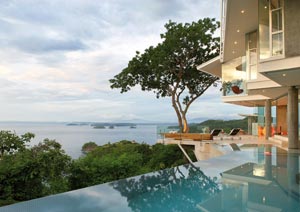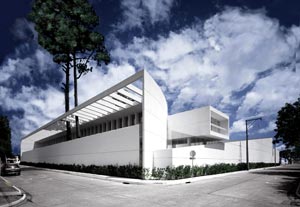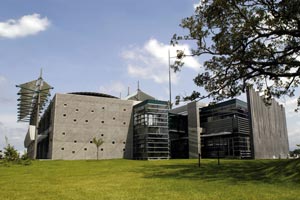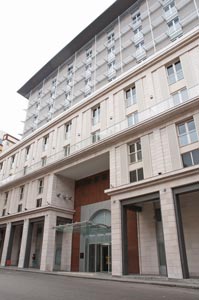
There was almost no presence of these regionsof the Americas in the global views of modern architecture published in Europe or the United States, although the Caribbean basin covers 2.7 million km2 (the Mediterranean basin has 2.6 million km2), and includes nearly twenty countries with a total of approximately 50 million inhabitants. What are the reasons for this marginalization? Perhaps a stereotyped image limited to cruises, money laundering or the last bastion of Western socialism? In the first place, the small size, the fragmentation and poverty of most countries did not facilitate the architectural movements’ coherent development, similar to those that occurred in the larger nations of the continent. In second place, since Central America and the Caribbean are a type of crossroads, a social space of systole and diastole, in which external influences outweighed the internal elaborations in the field of architecture and urbanism. On the other hand, since the colonial period up to the recent twenty-first century, a typical “Caribbean” personality was conceived, popular and spontaneous; and in the thirties, while the ideas of modernism became widespread, this became part of a creative symbiosis that characterized modern regional architecture. Since then, new generations of local professionals developed innovative solutions that today take part in the international level global dialogue.
At the same time as Caribbean architecture became world famous by means of coffee table books of the Taschen publishing house, who spread the vernacular examples in Caribbean Style, during the last two centuries a genuine culture of international significance was forged: in 1967 the Guatemalan Miguel Angel Asturias, and then West Indians Derek Wallcott in 1992, and V.S. Naipaul in 2001, won the Nobel Prize for Literature. Previously since the nineteenth century writers such as José Martí in Cuba and Ruben Dario in Nicaragua marked the path of Latin American literary modernism. The dialogue between European Surrealism and the Caribbean was also intense: André Breton was marveled by Martinique’s nature and popular cultural manifestations; under the aegis of Aimé Césaire, and the Cuban writer Alejo Carpentier, “magic realism” was discovered, while rising to King Christophe’s Citadel in Haiti. Undoubtedly, music played an essential role in this region’s presence in the world: Ernesto Lecuona’s habaneras, so well known in Spain; Harry Belafonte’s calypso and Bob Marley’s Rastafari reggae in Jamaica; the Dominican Juan Luis Guerra’s salsa; the presence of Puerto Ricans in New York repeatedly through West Side Story, and the universal success of revolutionary Cuba’s artists: the ballerina Alicia Alonso, and the New Trova singers Silvio Rodriguez and the Pablo Milanes.
What were the elements of tradition which modern architects took on in order to develop a language that would establish a dialogue amid universal and local issues, promoting the so called “environmental Caribbean syncretism”? In Central America, the presence of the Mayan ruins and having to adapt the Spanish colonizers’ buildings to the seismic character of the region, with thick columns in patios and galleries, inspired the formal parameters of some contemporary buildings: the National Theatre’s pyramidal configuration (1978) by Efrain Recinos and volumetric Mexican Embassy (2007) by Teodoro González de León and Francisco Serrano in Guatemala City. But undoubtedly, the greatest influence came from nineteenth century buildings, both from newly developed “tropical” housing typologies, as well as functional solutions associated with banana plantations. The import of the balloon frame structure applied to individual residences and the replacement of the open courtyard by the shaded porch, as well as the use of prefabricated iron structures in warehouses and stores, imported from England and the United States, established the guidelines to solutions which were adapted to the climate, whose lightness and transparency allowed the desired shade and the breeze’s circulation inside buildings; were all constants that appeared in the recent works of Costa Ricans Bruno Stagno, Victor Cañas and Rolando Barahona, as well as the Panamanian Patrick Dillon.
 In the West Indian universe, the Spaniards found Indian huts of bamboo, wood, thatched roofs –named cana or guano–, similar to the Vitruvian primitive hut, then magnified by eighteenth century European treaties, and accepted as contemporary models in resorts , clubs mediterranée, and some examples of good architecture, such as the works of Oscar Imbert and Segundo Imbert in the Dominican Republic: to mention, among others, the Punta Cana airport (1985) and the Beach Club Caletón (2005).
In the West Indian universe, the Spaniards found Indian huts of bamboo, wood, thatched roofs –named cana or guano–, similar to the Vitruvian primitive hut, then magnified by eighteenth century European treaties, and accepted as contemporary models in resorts , clubs mediterranée, and some examples of good architecture, such as the works of Oscar Imbert and Segundo Imbert in the Dominican Republic: to mention, among others, the Punta Cana airport (1985) and the Beach Club Caletón (2005).
On the islands of English, French and Dutch colonization, urban development was of lesser importance compared to the primacy of the sugar plantations. In which a great contrast existed between basic slave quarters, iron and wood industrial facilities, and the luxurious mansions of the landlords, designed according to Palladian models, reference still present in current projects. However, the dominant trend emerged in the nineteenth century with the widespread use of the balloon frame in housing, and metallic structures for markets and stores, which responded both to the climatic conditions and the requirements due to potential earthquakes, as well as the provisional status of productive structures. The lightness and transparency of these buildings defined Caribbean architecture’s dominant typology, as well as the Victorian gingerbread decorative system. However, the academic interlude that took place in the early twentieth century interrupted the continuity of the vernacular heritage, which was taken up again, since the thirties, with the assimilation of modernism’s functional and aesthetic principles. Thus, during the second half of the twentieth century modern Caribbean architecture’s personality was taking shape.
Richard Neutra was the Modern Movement’s driving force in the Caribbean, with his lectures, projects and works in Cuba and Puerto Rico. Leaving his disciple Henry Klumb, whose copious architectural production established the bridge between tradition and modernity, adapting modern language to the specific climatic and ecological conditions of the region. Since the fifties many visits of European Masters to the Caribbean took place: Walter Gropius, Mies van der Rohe, Jose Luis Serty and Félix Candela arrived in Havana; and Moise Shafdie designed the Habitat of Puerto Rico. U.S. influence was present through Welton Beckett, author of Havana Hilton in Havana (1958, current Habana Libre); and from Edward Larrabee Barnes, with the “El Monte” apartments in San Juan (1965). The questioning of International Style had already begun to happen in Cuba at the National Art Schools (1961-2010), a project involving the Cuban Ricardo Porro together with the Italians Roberto Gottardi and Vittorio Garatti, was extended by Bruno Stagno and Jimena Ugarte in Costa Rica, having both emigrated from Chile in 1973. Identification with the reality of Central America and the Caribbean, and the awareness of the serious environmental problems that were to come turned Stagno into the defender of the search for a “tropical” architecture, not only of the Americas, but on a global scale, together Gustavo Luis Moré of the Dominican Republic, editor of the leading journal of Caribbean architecture, Archivos de Arquitectura Antillana (AAA). Supported by the Prince Claus Fund from Holland and clearly identified with the thesis of “critical regionalism” by Alexander Tzonis and Liane Lefaivre, Moré created the Institute of Tropical Architecture (1994), which in successive seminars throughout this century brought together the major players from all five continents, aimed at the creation of a sustainable and ecological architecture.
Two contrasting situations attracted international attention to the Caribbean. On one hand, enthusiasm due to the economic boom of the globalized capitalist world since the early nineties, –until the recent global crisis (2008)–, which fueled a construction boom in the region, associated with the progressive growth of tourism and real estate speculation (Panama City, with a little more than a million people has 127 high buildings). This dynamic even generated a sophisticated school of architecture and design-ISTHMUS, located in the “City of Knowledge”, which occupies the former Panama Canal U.S. military installations, directed by the Colombian Carlos Morales, whose international projection aims to train talented professionals that will work in the region. On the other hand, concerns remain about the deep social contradictions that prevail in most countries and the precarious living conditions of the neediest stratus of the population, that have settled in the urban peripheries of chaotic cities in lack of urban planning. The presence of star system international architects, accompanied the anxiety in taking part of the benefits of the “Bilbao effect”, and creating a regional urban visibility. Ricardo Legorreta designed the Metropolitan Cathedral of Managua (1991-1993), with a contradictory language of dissimilar references; and Frank Gehry –married to a Panamanian–, is invited to project the Museum of Biodiversity (2002) in Panama, located at Amador, at the gates of the canal, conceived as an encounter between the geological and the social history of the region, and in which the customary typology of fluctuating sinus rooftops still remains. Closer to the local historical tradition is the Mexican Embassy in Guatemala by Teodoro González de León and Francisco Serrano (2007), a snowy set of complex volumes that strive to represent, in a modern code, the Mayan pyramids’ stone masses. Furthermore the patterns and the transparency so characteristic of Antillean tradition are featured in the Ministry of Justice’s headquarters in Fort de France, Martinique (2003), by Borja García Huidobro and Alexander Chementov. Finally, Rafael Moneo was summoned by Havana’s City Historian to design a hotel in the Centro Histórico (historical center, 2009).
 The interest in the conservation of the architectural and urban Caribbean heritage, as well as the safeguard of traditional cities, in most countries threatened by real estate speculation, created an international movement to support local initiatives, and of widespread recognition of the historical past. In first place, UNESCO added a great number of cities, buildings and natural surroundings to the World Heritage list; citing, among others, the historical centers of Havana, Camagüey, Cienfuegos and Trinidad in Cuba; Santo Domingo; Panama; San Juan of Puerto Rico; Antigua in Guatemala. At the same time, the Junta of Andalucía published detailed guides of some of these cities.
The interest in the conservation of the architectural and urban Caribbean heritage, as well as the safeguard of traditional cities, in most countries threatened by real estate speculation, created an international movement to support local initiatives, and of widespread recognition of the historical past. In first place, UNESCO added a great number of cities, buildings and natural surroundings to the World Heritage list; citing, among others, the historical centers of Havana, Camagüey, Cienfuegos and Trinidad in Cuba; Santo Domingo; Panama; San Juan of Puerto Rico; Antigua in Guatemala. At the same time, the Junta of Andalucía published detailed guides of some of these cities.
In the recent decade very few works have escaped beyond the anonymity of commercial and speculative architecture, or from uncalled-for formalism imposed by international trends and of Miami’s influence. These works materialized due to the initiative of enlightened managers that associated fine architecture with the prestige their company, or cultured clients who wanted customize their homes, moving away from the usual false vernacular stereotypes. Costa Rica, as well demonstrated by Miquel Adria and Luis Diego Barahona, is the Central American country with the greatest construction of buildings of high aesthetic level, carried out by Bruno Stagno, Victor Cañas and Jaime Rouillón. Stagno, in all of his extensive work, sought the harmonious balance between formal Costa Rican typologies, traditional responses to climatic and ecological conditions, economic sustainability and the use of local materials and modern technology, at the same time striving to achieve “the divine proportions” between nature and architecture. Formed in the Modern Movement’s canonical tradition –he worked with Jullian and Ouvrerie in the church project of Firminy, Le Corbusier–, in recent projects (Holcim company offices, 2004, and British American Tobacco, 2008) he freed himself from rationalistic bonds, while designing the external solar protection systems with free plastic forms: in the first, some light plastic sheeting supported by metal clamps; in the second, a system of undulated brises that extend along the facade. The interior spaces were extremely elaborate, in which a shadowy atmosphere is achieved together with a passing breeze, in this manner minimizing the use of air conditioning.
From a younger generation, Victor Cañas, Rolando Barahona and Jaime Rouillón feel less tied up to the environmental axioms and more attracted to deconstructive expressiveness, minimalist modesty and spatial imagination associated to high tech. In the Caña houses –Hovany (2003), Holmes (2004) and Portas Novas (2005)–, the alternation of opacity and transparency in the ascetic interior spaces prevails, imaginative use of protective solar panels, adapting to the site’s topography and creating perspectives towards the magnificence of the landscape, highlighted by the mirror images created by the ponds. And Rolando Barahona, in the houses Rising Horizon Living Sanctuary, establishes a dialogue between the plants’ geometric complexity and the external volumes adapted to the topography, the presence of stone walls contrasting with fine steel columns that frame the large glass panes that open our views into space. Also belongs to this trend, by integrating vernacular traditions with a contemporary expression, the Panamanian Patrick Dillon. The SaLo house in Veraguas amplifies the virtual outer walls defined by wooden blinds; and invents a homemade high tech solution in the observation tower located on the edge of a national park in Gamboa, in which its free and irregular shape, comes from the use of recovered materials from the area in homes, offices, garages, sheds and a demolished refinery nearby. The efforts of the architect Angela Stassano in Honduras, should also be noted, who achieved an economic and bioclimatic architecture, without sacrificing any aesthetic attributes: the chromatic solution of the Bed & Breakfast (2010) hotel cottages is original.
 The houses built in the West Indies were more traditional, due to increased pressure from vernacular traditions associated with the dynamics of international tourism, in search of the elusive Lost Paradise. A collection of luxurious residences in the Batey of Casa de Campo in La Romana, Dominican Republic, within the exclusive and sophisticated domain of American millionaires, by the Venezuelan Francisco Feaugas, try to find the balance between the use of traditional materials and forms and a contemporary singularity. The spaces created by Jerome Novel in Martinique, are more innovative, experimenting with courtyards and continuous external galleries; as well as the chromatic house in Willemstad, Curacao, by Carlos Weeber and Sofia Saavedra (2005), which assumes the colorful heritage of Dutch architecture. The ecological experience of the small “absent home” from Abruña & Musgrave in Vega Alta, Puerto Rico, is unique, whose simple volumetric elements establish a symbiosis of open and covered spaces, taking upmost advantage of: rain water, the wind and solar energy. The attention to the poorest sections of the population of Puerto Rico is manifested in the housing project of Edwin and Ivan Quiles (2009), for residents of a slum and the interactive environmental education center “Aula Verde” (2002) in Rio Piedras, by the Toro and Ferrer studio, in an initiative associated with Harvard University. Located on the edge of a small forest and associated with a butterfly garden, expresses its modesty in formal and constructive asceticism: the block dedicated to educational activities, is defined by a reinforced concrete structure in plain sight and by rustic wooden windows.
The houses built in the West Indies were more traditional, due to increased pressure from vernacular traditions associated with the dynamics of international tourism, in search of the elusive Lost Paradise. A collection of luxurious residences in the Batey of Casa de Campo in La Romana, Dominican Republic, within the exclusive and sophisticated domain of American millionaires, by the Venezuelan Francisco Feaugas, try to find the balance between the use of traditional materials and forms and a contemporary singularity. The spaces created by Jerome Novel in Martinique, are more innovative, experimenting with courtyards and continuous external galleries; as well as the chromatic house in Willemstad, Curacao, by Carlos Weeber and Sofia Saavedra (2005), which assumes the colorful heritage of Dutch architecture. The ecological experience of the small “absent home” from Abruña & Musgrave in Vega Alta, Puerto Rico, is unique, whose simple volumetric elements establish a symbiosis of open and covered spaces, taking upmost advantage of: rain water, the wind and solar energy. The attention to the poorest sections of the population of Puerto Rico is manifested in the housing project of Edwin and Ivan Quiles (2009), for residents of a slum and the interactive environmental education center “Aula Verde” (2002) in Rio Piedras, by the Toro and Ferrer studio, in an initiative associated with Harvard University. Located on the edge of a small forest and associated with a butterfly garden, expresses its modesty in formal and constructive asceticism: the block dedicated to educational activities, is defined by a reinforced concrete structure in plain sight and by rustic wooden windows.
It would be impossible to conclude this brief overview without referring to the urban topic and to interventions in its historical centers. In the region, the dynamic constructions of Panama City and Santo Domingo and the immobility of Havana due to the economic crisis affecting Cuba over the last two decades, contrast greatly. There are projects of hotels located in the historic center, developed by Jose Antonio Choy and Julia Leon, like the Central Park hotel new building–in collaboration with Langdon and Ass, and Atelier Catherine Grenier–, and another located on Prado and Malecón, of which only the first one took shape recently (2010). On the one hand, the large professional offices complete monumental public works in the cities –Segundo Cardona, the Coliseo de Puerto Rico (2004); Gustavo Luis Moré and Juan Cristobal Caro, the Supreme Court in Santo Domingo (2001); and the same city Andres Sanchez and Cesar Curiel, the rigorous Holiday Inn Hotel (2009); Seisarquitectos, the Banco Industrial in Guatemala City (2008); Mallol & Mallol, the Government Complex in Panama City (2002)– on the other hand, there is a movement to preserve and recycle historic architecture: the buildings restored by Eduardo Tejeira-Davis in the old city of Panama and the Museum of San Juan, located in the Old Market (2000), by Bermudez, Delgado and Diaz. But at the same time, particularly in San Juan, the socialization and community use of public spaces has been encouraged. The landscape work by Andres Mignucci is exceptional, as well as the series of parks located in different areas of the city. “Window to the Sea” (2006) excels, opposite the beach between the hotels La Concha and Vanderbilt, traditionally a space closed to the public. Tin this manner, a movement is being generated to experience daily urban spaces by means of their social life, keeping alive the Caribbean tradition of outdoor activities, –let us remember the traditional iron markets–, as opposed to the anti-urban and segregating dynamics of shopping centers and gated communities.
Unfortunately, the economic interests that control tourism in the region do not encourage the desired integration between cities and vacation resort settlements, which are based on their isolation and autonomy from the islands’ existing urban infrastructure. Thus, this desired Paradise is experienced by millions of foreign visitors, alien and distant from the harsh realities of the Caribbean universe.
* An extended version of this essay was published in LUIS FERNÁNDEZ-GALIANO (Ed.): Atlas. Arquitecturas del siglo XXI, América, Bilbao, Fundación BBVA, 2010.
Related Publications

How Harumi Yamaguchi invented the modern woman in Japan
March 16, 2022












